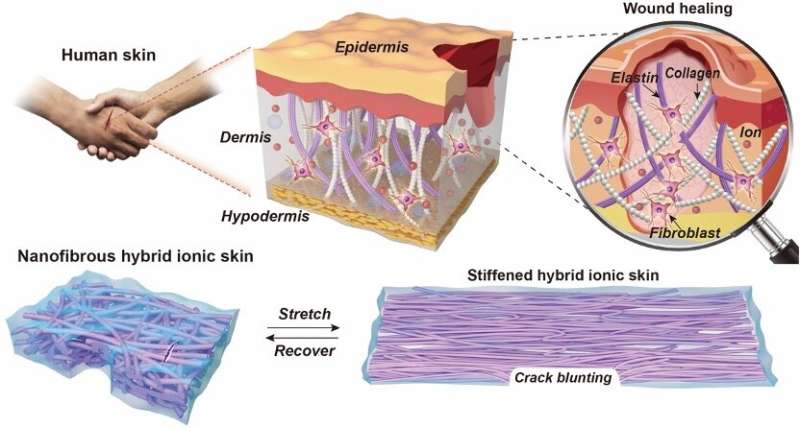September 6, 2022 feature
A soft, fatigue-free and self-healing artificial ionic skin

In recent years, roboticists and material scientists worldwide have been trying to create artificial systems that resemble human body parts and reproduce their functions. These include artificial skins, protective layers that could also enhance the sensing capabilities of robots.
Researchers at Donghua University in China and the Jülich Centre for Neutron Science (JCNS) in Germany have recently developed a new and highly promising artificial ionic skin based on a self-healable elastic nanomesh, an interwoven structure that resembles human skin. This artificial skin, introduced in a paper published in Nature Communications, is soft, fatigue-free and self-healing.
"As we know, the skin is the largest organ in the human body, which acts as both a protective layer and sensory interface to keep our body healthy and perceptive," Shengtong Sun, one of the researchers who carried out the study, told TechXplore. "With the rapid development of artificial intelligence and soft robotics, researchers are currently trying to coat humanoid robots with an 'artificial skin' that replicates all the mechanical and sensory properties of human skin, so that they can also perceive the everchanging external environment like us."
As the human skin is a highly complex and sophisticated system, mimicking all its functions can be extremely challenging. For instance, the human skin can sense a variety of environmental changes, including pressure, deformation of its surface and temperature variations, simply by picking up ion-based electronic signals.
"The human skin feels soft, but it becomes highly firm when stretched," Sun said. "The skin can also naturally heal wounds in a few days by fully repairing its structure and functions. More importantly, over about 1 million cycles of deformations per year along with body movements, skin's properties will not degrade, suggesting very good anti-fatigue properties."
Although material scientists have recently devised several artificial skins, also referred to as electronic or ionic skins, most of these systems can only reproduce a part of the skin's natural attributes. Sun and his colleagues have been trying to design more skin-like and realistic materials for several years.
"While conducting our studies, we noticed that the skin combines several intriguing properties by a hierarchical nanofibrous structure, which is defined by a stiff collagen fibril scaffold embedded in the soft interwoven elastin matrix," Sun said. "These two phases not only heal with the aid of dermal fibroblasts upon wound, but also impart very high fracture toughness to human skin by pinning damage at the hard collagen nanofibrils."
Drawing inspiration from the skin's natural structure, the researchers set out to design a new artificial skin based on a self-healable nanomesh and an ionic matrix, which can replicate the functions of collagen and elastin, respectively. This resulted in a skin-like material that is soft but becomes firm when stretched, a property known as "strain stiffening." In addition, their artificial skin can autonomously heal itself after being damaged, is resistant to fatigue, and rapidly responds to shape deformations, which is particularly desirable for sensing applications.
"Inspired by skin's repairable nanofibrous structure, we created an artificial ionic skin by embedding a self-healable elastic nanomesh scaffold into another self-healable soft ionic matrix," Sun said. "The nanomesh was produced by electrospinning our synthetic polyurethane which can self-heal by disulfide bond exchange at room temperature. The ionic matrix was made by evaporating the aqueous solution of poly(acrylamide-co-acrylic acid), hyaluronic acid, and CaCl2, which can heal with the aid of moisture. Owing to the healability of the two parent materials, the hybrid ionic skin can also heal damages within a short period of time."
The artificial skin created by Sun and his colleagues has a unique elastic and nanofibrous structure that makes it highly resistant to fatigue. More specifically, its embedded polyurethane nanofibers can cover large force transfer lengths, thus blunting cracks and preventing them from further propagating.
In initial evaluations, the artificial skin system achieved very promising results. The team found that even with a pre-cut notch on it, the hybrid ionic remained intact for over 10,000 stretching cycles. The calculated fatigue threshold of hybrid ionic skin is ~2,950 J m-2, almost two times higher than human muscle (1,000 J m-2).
"Softness and stretchability are the two most important mechanical properties for skin-like sensing materials," Sun said. "However, conventional material designs for softness and stretchability often lead to the low robustness, which is averse to the service life of ionic skins. We tackled this problem by producing a hybrid ionic skin which mimics the repairable nanofibrous structure of human skin."
The skin-like system created by this team of researchers is among the first artificial skins that are not only soft and stretchable, but also reliably self-healing and fatigue-resistant. In the future, the design proposed by Sun and his colleagues could be used to create other robust and ion-conducting structures based on other material combinations.
In addition, their artificial skin system could aid the development of humanoid robots that are more fatigue-resistant, better performing and are not as easily damaged over time. While the team's ionic skin achieved remarkable results so far, it still has some notable limitations, which Sun and his colleagues are eventually hoping to overcome.
"Because we used hygroscopic hydrogel as the ionic matrix, the environmental stability is relatively poor, especially at moisture-changing conditions," Sun added. "In very dry environmental conditions, the ionic matrix will become hard by losing water, and the skin's ability to self-heal will also be difficult to realize. To overcome this limit, we are now motivated to produce even more robust ionic skins that can reliably work in harsh conditions, such as low and high temperatures, underwater, vacuum, or in the presence of corrosive substances. This will be very useful for soft robots that are expected to operate in even more complicated and variable environments than those inhabited by humans."
More information: Jiqiang Wang et al, Fatigue-free artificial ionic skin toughened by self-healable elastic nanomesh, Nature Communications (2022). DOI: 10.1038/s41467-022-32140-3
© 2022 Science X Network


















